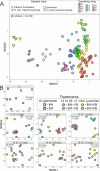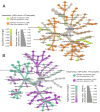Dynamics, diversity, and roles of bacterial transmission modes during the first asexual life stages of the freshwater sponge Spongilla lacustris
- PMID: 38851755
- PMCID: PMC11162577
- DOI: 10.1186/s40793-024-00580-7
Dynamics, diversity, and roles of bacterial transmission modes during the first asexual life stages of the freshwater sponge Spongilla lacustris
Abstract
Background: Sponge-associated bacteria play important roles in the physiology of their host, whose recruitment processes are crucial to maintain symbiotic associations. However, the acquisition of bacterial communities within freshwater sponges is still under explored. Spongilla lacustris is a model sponge widely distributed in European rivers and lakes, producing dormant cysts (named gemmules) for their asexual reproduction, before winter. Through an in vitro experiment, this study aims to describe the dynamics of bacterial communities and their transmission modes following the hatching of these gemmules.
Results: An overall change of bacterial β-diversity was observed through the ontology of the juvenile sponges. These temporal differences were potentially linked, first to the osculum acquisition and the development of a canal system, and then, the increasing colonization of the Chlorella-like photosymbionts. Gemmules hatching with a sterilized surface were found to have a more dispersed and less diverse microbiome, revealing the importance of gemmule epibacteria for the whole holobiont stability. These epibacteria were suggested to be vertically transmitted from the maternal tissues to the gemmule surface. Vertical transmission through the incorporation of bacterial communities inside of the gemmule, was also found as a dominant transmission mode, especially with the nitrogen fixers Terasakiellaceae. Finally, we showed that almost no ASVs were shared between the free-living community and the juveniles, suggesting that horizontal recruitment is unlikely to happen during the first stages of development. However, the free-living bacteria filtered are probably used as a source of nutrients, allowing an enrichment of copiotrophic bacteria already present within its microbiome.
Conclusions: This study brings new insight for a better understanding of the microbiome acquisition during the first stages of freshwater sponge development. We showed the importance of epibacterial communities on gemmules for the whole holobiont stability, and demonstrated the near absence of recruitment of free-living bacteria during the first stages.
Keywords: Freshwater sponge; Gemmule; Holobiont; Horizontal acquisition; Microbiome; Ontogeny; Vertical transmission.
© 2024. The Author(s).
Conflict of interest statement
The authors declare no competing interests.
Figures






Similar articles
-
Correlation of cyclic GMP and cyclic AMP immunofluorescence with cytochemical patterns during dormancy release and development from gemmules in Spongilla lacustris L. (Porifera: Spongillidae).J Morphol. 1981 Jan;167(1):53-63. doi: 10.1002/jmor.1051670106. J Morphol. 1981. PMID: 30114857
-
Microbiome changes through the ontogeny of the marine sponge Crambe crambe.Environ Microbiome. 2024 Mar 11;19(1):15. doi: 10.1186/s40793-024-00556-7. Environ Microbiome. 2024. PMID: 38468324 Free PMC article.
-
Secondary Metabolite Production Potential in a Microbiome of the Freshwater Sponge Spongilla lacustris.Microbiol Spectr. 2023 Feb 2;11(2):e0435322. doi: 10.1128/spectrum.04353-22. Online ahead of print. Microbiol Spectr. 2023. PMID: 36728429 Free PMC article.
-
Freshwater Sponges as a Neglected Reservoir of Bacterial Biodiversity.Microorganisms. 2023 Dec 22;12(1):25. doi: 10.3390/microorganisms12010025. Microorganisms. 2023. PMID: 38257852 Free PMC article. Review.
-
The sponge holobiont in a changing ocean: from microbes to ecosystems.Microbiome. 2018 Mar 9;6(1):46. doi: 10.1186/s40168-018-0428-1. Microbiome. 2018. PMID: 29523192 Free PMC article. Review.
Cited by
-
Freshwater sponges in the southeastern U.S. harbor unique microbiomes that are influenced by host and environmental factors.PeerJ. 2025 Jan 30;13:e18807. doi: 10.7717/peerj.18807. eCollection 2025. PeerJ. 2025. PMID: 39897492 Free PMC article.
References
-
- de Goeij JM, Lesser MP, Pawlik JR. Nutrient fluxes and ecological functions of coral reef sponges in a changing ocean. In: Carballo JL, Bell JJ, editors. Clim Change Ocean Acidif sponges impacts mult levels Organ. Cham: Springer International Publishing; 2017. pp. 373–410.
-
- Slaby BM, Franke A, Rix L, Pita L, Bayer K, Jahn MT, et al. et al. Marine sponge holobionts in health and disease. In: Li Z, et al.et al., editors. Symbiotic Microbiomes Coral Reefs sponges corals. Dordrecht: Springer Netherlands; 2019. pp. 81–104.
-
- De Castro-Fernández P, Ballesté E, Angulo-Preckler C, Biggs J, Avila C, García-Aljaro C. How does heat stress affect sponge microbiomes? Structure and resilience of microbial communities of marine sponges from different habitats. Front Mar Sci. 2023;9.
Grants and funding
LinkOut - more resources
Full Text Sources
